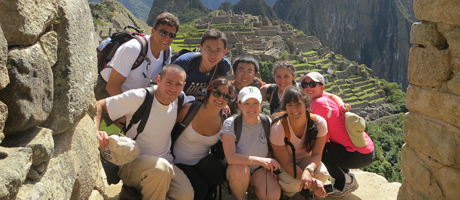George Washington tourism and international affairs students team up to help the city of Cusco, Peru.
One of the main reasons Lynette Andrews came to George Washington for her master’s in tourism administration was the international consulting practicum.
In prior years, students have found themselves in Belize or Portugal. This summer, the practicum soared to new heights: 11,000 feet up in the Andes in the city of Cusco, Peru.
“It is one thing to learn about research, tourism planning and policy from a textbook,” said Ms. Andrews, a second-year master’s student in tourism administration. “But it is raised to another level when you have an actual client and the outcomes of the project can really affect those who you are doing the consulting work for.”
With an agreement with the municipality of Cusco and tourism officials there, Ms. Andrews and her tourism program classmates—led by Kristin Lamoureux, director
of GW’s International Institute of Tourism Studies—headed to the former capital of the Inca Empire for their two-week project.
They teamed up with students who were taking a class through GW Study Abroad and the Elliott School of International Affairs in survey methods in the developing world. Their professor was Justin Fisher, a GW lecturer and senior statistician at the U.S. Government Accountability Office.
The students designed and, with some help from local students at the University of San Ignacio de Loyola, conducted a survey to learn more about the tourists in Cusco. What brought them there? What had they seen? Did they make it to the famous San Pedro Market?
It all culminated into a final presentation for Cusco leaders, including tourism officials and the vice mayor. With their data, the students had a strong case for how to enhance the city’s tourism.
They recommended positioning Cusco as a culinary hotspot, highlighting its famous ceviche (a seafood dish “cooked” by its acidic marinade), pollo a la brasa (roasted chicken), cuy (guinea pig, a local delicacy) and pisco (a grape liquor), and moving tourists away from the “five-star” area and into the local communities that could really use the economic boost.
The students also suggested livening up the open-air, massive market that plays a central role in Cusco. They recommended creating a “Friends of San Pedro Market” organization that could help support high-profile events, like a Food Network competition. The students even connected Cusco officials to farmers’ market organizers all the way in Madison, Wisc., Cusco’s sister city, for what they hope will become a budding mentorship program. And why not apply to be a UNESCO City of Gastronomy?
The recommendations were well-received, and the vice mayor promised to start a task force to explore some of them, Ms. Lamoureux said.
“She actually started crying, she was so emotional about the response, and just so happy about the efforts that had been put forward for Cusco,” she said. “It was tremendously successful.”
Ms. Lamoureux added she always has the same goal on these trips: that the students take away a real-life application of what working in tourism development “on the ground” is like.
“It’s not easy,” she said. “It’s full of sudden changes, lots of adapting.”
The students took well to it.
“Now, I have a drastically better grasp of the time and work that it takes to be a tourism consultant,” Ms. Andrews said. “This class has given me the necessary experience and confidence to feel qualified for a tourism consulting position.”
Mr. Fisher’s students also benefited.
“This course has most definitely provided me with a useful tool to add to my development practitioner ‘tool belt,’ ” said Felicia Rodriguez, a master’s student in international development with a concentration in rural development. Ms. Rodriguez added that, thanks in part to her Cusco experience, she was assigned to lead a community needs assessment for a non-governmental organization in the Sacred Valley in Peru.
Namitha Jacob, a second-year master’s student in international affairs, echoed Ms. Rodriguez’s sentiments.
“I had been wanting to take a class on survey methods because it is a very in-demand skill needed in the international development workplace,” she said. “The class was real-world experience.”


